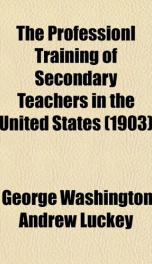the professionl training of secondary teachers in the united states

Purchase of this book includes free trial access to www.million-books.com where you can read more than a million books for free. This is an OCR edition with typos. Excerpt from book: value. Two ideas became prominent, the one, to extend the number of new subjects, the other, to shorten the time given to the classics by means of better methods, and to add to this curriculum some of the real studies. Neither of these views wholly prevailed; the latter exerted much influence in modifying the classical schools, while the former, somewhat changed, became the ideal of the elementary and normal schools. The thing that was most desired at first was PRACTICAL AND . . . , , . , Industrial not cu'ture but knowledge and the power of imparting that knowledge to others. This gave the normals a practical and industrial, though somewhat narrow turn, which they still retain. Agriculture, mechanic arts, manual training, silk industry, weaving, cooking, etc., were subjects quite frequently introduced into the curriculum. Among the principal forces that have been at work in shaping the development of these institutions may be mentioned the pietists under Francke, the philanthropists under Basedow, educational reformers like Pestalozzi, Felbiger and Diesterweg, the clergy, long the guardian of all education, jealous of its power and unwilling to give up its authority, and the central government, always aggressive in extending its power and influence.1 The normal schools have taken on a distinctly German character. They represent the interests of the common people. They promulgate class distinction by offering a course unsuited to advancement in the higher institutions. Thorough academic instruction over a limited field by methods which are intended as a guide for the pupil teacher, observation and criticism of school work and practice teaching according to model, are the principal features for which they stand. 1 Compare Barnard's National Education in the German...
Info about the book
Author:
Series:
Unknown
ISBN:
5876955620
Rating:
2.5/5 (2)Your rating:
0/5
Languge:
English
Users who have this book
Users who want this book
What readers are saying
What do you think? Write your own comment on this book!
write a commentif you like the professionl training of secondary teachers in the united states try:
Other books by this author
Do you want to read a book that interests you? It’s EASY!
Create an account and send a request for reading to other users on the Webpage of the book!


